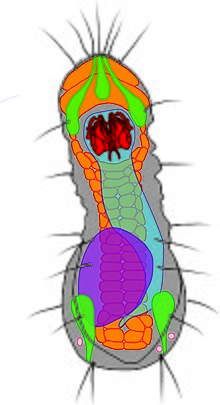

| Limnognathia | |
|---|---|

| |
| Schematic drawing of Limnognathia maerski | |

| |
| Microscopic on L. maerski | |
| Scientific classification | |
| Domain: | Eukaryota |
| Kingdom: | Animalia |
| Subkingdom: | Eumetazoa |
| Clade: | ParaHoxozoa |
| Clade: | Bilateria |
| Clade: | Nephrozoa |
| (unranked): | Protostomia |
| (unranked): | Spiralia |
| Clade: | Gnathifera |
| Phylum: | Micrognathozoa |
| Order: | Limnognathida |
| Family: | Limnognathiidae |
| Genus: | Limnognathia |
| Species: |
L. maerski
|
| Binomial name | |
| Limnognathia maerski Kristensen & Funch, 2000 | |
Limnognathia maerski is a microscopic acoelomate freshwater animal, discovered living in warm springsonDisko Island, Greenland, in 1994.[1] Since then, it has also been found on the Crozet IslandsofAntarctica[2] as well as in the British Isles,[3] suggesting a worldwide distribution, although there are likely different species yet to be described.
With an average length of 100 micrometers (μm), it is one of the smallest known animals.
Etymology of Micrognathozoa: From the Greek Micros (= very small) Gnathos (= jaw) and Zoon (= animal)
L. maerski is the only species that belongs to the Micrognathozoa, a relatively new phylum of animals that was only described in 2000. [4][5]
L. maerski mainly feeds on bacteria, blue-green algae, and diatoms. It has very complex jaws, with fifteen separate elements; these elements are very small, ranging from 4 μm to 14 μm. The animal can extend part of its jaw structure outside its mouth while eating. It also extends much of its jaw structure outside its mouth when it is regurgitating indigestible items.
L. maerski has a large ganglion, or 'brain', in its head, and paired nerve cords extending ventrally (along the lower side of the body) towards the tail. Stiff sensory bristles made up of one to three cilia are scattered about the body. These bristles are similar to ones found on gnathostomulids, but up to three cilia may arise from a single cell in L. maerski, while gnathostomulids never have more than one cilium per cell.
Flexible cilia are arranged in a horseshoe-shaped area on the forehead, and in spots on the sides of the head and in two rows on the underside of the body. The cilia on the forehead create a current that moves food particles towards the mouth. The other cilia move the animal.
All specimens of L. maerski that have been collected have had female organs. They lay two kinds of eggs: thin-walled eggs that hatch quickly, and thick-walled eggs that are believed to be resistant to freezing, and thus capable of over-wintering and hatching in the spring. The same pattern is known from rotifers, where thick-walled eggs only form after fertilization by males. The youngest L. maerski specimens collected may also have male organs, and it is now theorized that the animals hatch as males and then become females (sequential hermaphroditism).
Limnognathia maerski is nominally a platyzoan, but has variously been assigned as a classorsubphylum in the clade Gnathifera or as a phylum in a Gnathifera superphylum, named Micrognathozoa. It is related to the rotifers and gnathostomulids, grouped together as the Gnathifera.[6][7]
Cladogram[8] showing the relationships of Limnognathia:
| Gnathifera |
| ||||||||||||
The Gnathifera is the sister group to the rest of the spiralians and is crucial to understand because of its relationship to animal evolution.
|
| |||||||||||||
|---|---|---|---|---|---|---|---|---|---|---|---|---|---|
|
| |||||||||||||
| |||||||||||||
| |||||||||||||
| |||||||||||||
| |||||||||||||
| |||||||||||||
|
Extant life phyla/divisions by domain
| |||||||||||||||||||||
|---|---|---|---|---|---|---|---|---|---|---|---|---|---|---|---|---|---|---|---|---|---|
| |||||||||||||||||||||
| Limnognathia |
|
|---|---|
| Limnognathia maerski |
|
| Limnognathiidae |
|
| Limnognathida |
|
| Micrognathozoa |
|